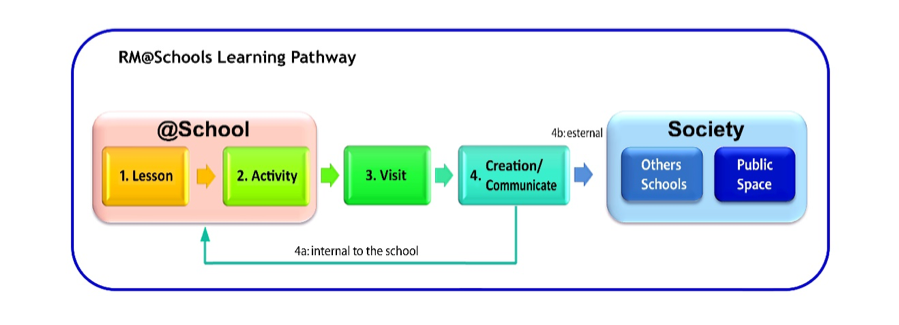These teaching resources introduce you to the RM@Schools methodology, namely the ‘learning pathway’, and related educational toolkits for use in the classroom. Both are intended as a guide for teachers and provide tips and information.
As a starting point we suggest that you browse through the resources and identify the parts you wish to cover. You can then use the introduction, the information in each section, and the content of specific toolkits to build the content of your lessons. In addition more detailed information about different topics can be found in the appendices, this may be useful for you if you are unfamiliar with certain topics or are looking for specific examples, or if your students are looking for information that they can use themselves.
Many of the toolkits provide a presentation with slides that can easily be included into your lessons. YouTube links to relevant videos are also available where appropriate. Many of the images are hyperlinked to the source the image came from and more detailed information about the topic can be found in there. Please feel free to use any of the images and slides presented on or linked to this website in your lessons.
RM@Schools has developed a specific educational path or methodology, called ‘the learning pathway’ which is intended to lead the students through a range of teaching methods and ends with the creation of a student-created piece of work that lets the students interact with the wider community. A core element of the RM@Schools approach is to empower students to communicate with peers and wider society about critical concepts related to raw materials and their use. RM@Schools designed this learning pathway to lead you and your students toward becoming RM@Schools Ambassadors and getting more involved in the programme.
The main steps of the RM@Schools learning pathway are shown in the diagrams below:


Students are involved in an active learning process by using a combination of approaches such as frontal lessons, open discussion, learning by doing, peer-to-peer education, creating communication material and gamification. These different educational approaches are used to generate and foster students’ interest in science and technology, in particular in circular economy and raw materials-related topics.
The learning pathway is oriented toward a common goal: students are guided to create a “product” to be communicated outside of the class. By doing this, students develop 21st century learning skills such as science inquiry skills, creativity, initiative, critical thinking, awareness of responsibility, communication and teamwork. As with any skills, being inquisitive and creative can be nurtured in the classroom with simple strategies and practices which trigger inquisitive and creative thinking and provide opportunities for communicative action. Ideas generate new ideas.
The RM@Schools learning pathway encourages students to collaborate, interact and solve problems with other students by grouping them into teams of four or five. Working in small groups is a good way to give space to everybody. It also prevents the “disappearance” of people too shy to participate. Each one has a role to play and a contribution to make. Students become science communicators themselves and this can lead to them becoming Young RM@Schools Ambassadors.
As teachers you can choose to use the whole RM@Schools learning pathway or select any parts of it as they best fit with your teaching and classroom needs. You are encouraged to use the information and toolkits in whatever way works for you in order to build a narrative around the use of raw materials in society.